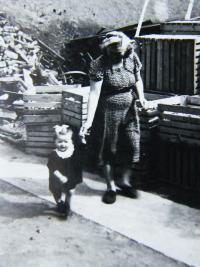The only thing I remember is the darkness

Download image
Jana Vávrová, née Nitková, was born June 29, 1941 in Prague. She lived with her parents in Kostelec nad Labem. Her mother was a seamstress and she had a dressmaker’s shop in Kostelec. Her father was working with his parents, who owned a haberdashery shop. He was a long-time member of Sokol. During the Protectorate he already held the rank of a Sokol chief. The local Sokol club in Mělník was involved in helping the paratroopers who had assassinated R. Heydrich. Jana’s father was collecting food stamps from people in order to ensure a supply of food to the assassins. He and other local Sokol functionaries were found by the Gestapo and arrested at the railway station in Neratovice on June 23, 1942. Mother and little Jana were arrested two months later, on August 27, 1942. Both were taken to the Petschek Palace in Prague (Gestapo headquarters - transl.’s note). The Gestapo members used a sly trick to take the one-year old baby from her mother. Jana’s parents were executed by the Nazis in the Mauthausen concentration camp on October 24, 1942 together with other members of Sokol from the Mělník region. Little Jana was placed in the infants hospital in Prague-Krč. Her aunt Mrs. Maršálková, the sister of Jana’s mother, found her there in December 1942. She has been searching for her niece since the summer of 1942. On May 5, 1945 her aunt came to the hospital in Krč with a repatriation decree to pick up Jana. The situation in Krč however didn’t allow her to take Jana with her at the moment. During the Prague Uprising, Jana had to stay in the infants hospital, but as soon as it became possible, the aunt and her husband came to pick her up and they adopted her. The Maršáleks didn’t have their own children yet; their son was born after the war, but he didn’t accept his older step sister. After elementary school, Jana Nitková did vocational training in ČKD Stalingrad. She subsequently worked there for seven years as a clerk. Then she briefly worked in the Research Institute for Heavy Industry, and then as a secretary in the Léčiva company. From 1969 she was working in the Youth Travel Agency, she passed exams for tour guides and then travelled as a guide. From 1972 she was working in the ČSA Czech Airlines in Prague at various positions, for the longest time in the marketing department for countries of Africa.


















